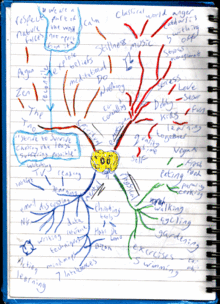Uses of Mind Mapping
A mind map is often created around a single idea, word or text, placed in the center, to which associated ideas, words and concepts are added.
Mind maps have many applications in personal, family, educational, and business situations, including notetaking, brainstorming (wherein ideas are inserted into the map radially around the center node, without the implicit prioritization that comes from hierarchy or sequential arrangements, and wherein grouping and organizing is reserved for later stages), summarizing, as a mnemonic technique, or to sort out a complicated idea. Mind maps are also promoted as a way to collaborate in color pen creativity sessions.

Mind maps can be used for:
- problem solving
- outline/framework design
- structure/relationship representations
- anonymous collaboration
- marriage of words and visuals
- individual expression of creativity
- condensing material into a concise and memorable format
- team building or synergy creating activity
- enhancing work morale
In addition to these direct use cases, data retrieved from mind maps can be used to enhance several other applications, for instance expert search systems, search engines and search and tag query recommender. To do so, mind maps can be analysed with classic methods of information retrieval to classify a mind map's author or documents that are linked from within the mind map. It finds application in many other fields as well.
Mindmaps can be drawn by hand, either as "rough notes" during a lecture or meeting, for example, or as higher quality pictures when more time is available. An example of a rough mind map is illustrated. There are also a number of software packages available for producing mind maps.